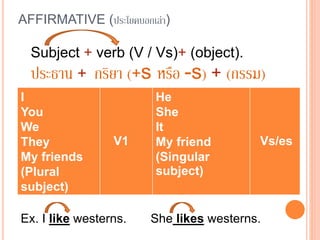Simple present
- 1. AFFIRMATIVE (āļāļĢāļ°āđāļĒāļāļāļāļāđāļĨāđāļē) Subject + verb (V / Vs)+ (object). āļāļĢāļ°āļāļēāļ + āļāļĢāļīāļĒāļē (+s āļŦāļĢāļ·āļ -s) + (āļāļĢāļĢāļĄ) I You We They My friends (Plural subject) V1 He She It My friend (Singular subject) Vs/es Ex. I like westerns. She likes westerns.
- 2. NEGATIVE āļāļĢāļ°āđāļĒāļāļāļāļīāđāļŠāļ Subject + donât/doesnât + V + (object). āļāļĢāļ°āļāļēāļ +(donât āļŦāļĢāļ·āļ doesnât) +āļāļĢāļīāļĒāļēāļĢāļđāļāđāļĢāļ + (āļāļĢāļĢāļĄ) I You We They My friends (Plural subject) donât + V He She It My friend (Singular subject) doesnât + V I donât like westerns. She doesnât like westerns.
- 3. QUESTION (āļāļĢāļ°āđāļĒāļāļāļē āļāļēāļĄ) Do /Does + Subject + V + (object)? Do āļŦāļĢāļ·āļ Does + āļāļĢāļ°āļāļēāļ + āļāļĢāļīāļĒāļēāļĢāļđāļāđāļĢāļ + (āļāļĢāļĢāļĄ)? Do you like salsa? Does she like salsa?
- 4. ïĒDo / Does + subject + verb? Ex. A: Do you like westerns? B: Yes, I do. / No, I donât. A: Does she like westerns? B: Yes, she does. / No, she doesnât.
- 5. Do you like pop? Yes, I do. I like it a lot. No, I don't like it very much. What kind of music do you like? I like rock a lot.
- 6. Does he play the guitar? Yes, he does. No, he doesn't. What does he play? He plays the drums.
- 7. Do they like Silly Fools? Yes, they do. They love them. No, they don't like them. Who do they like? They like Loso.






